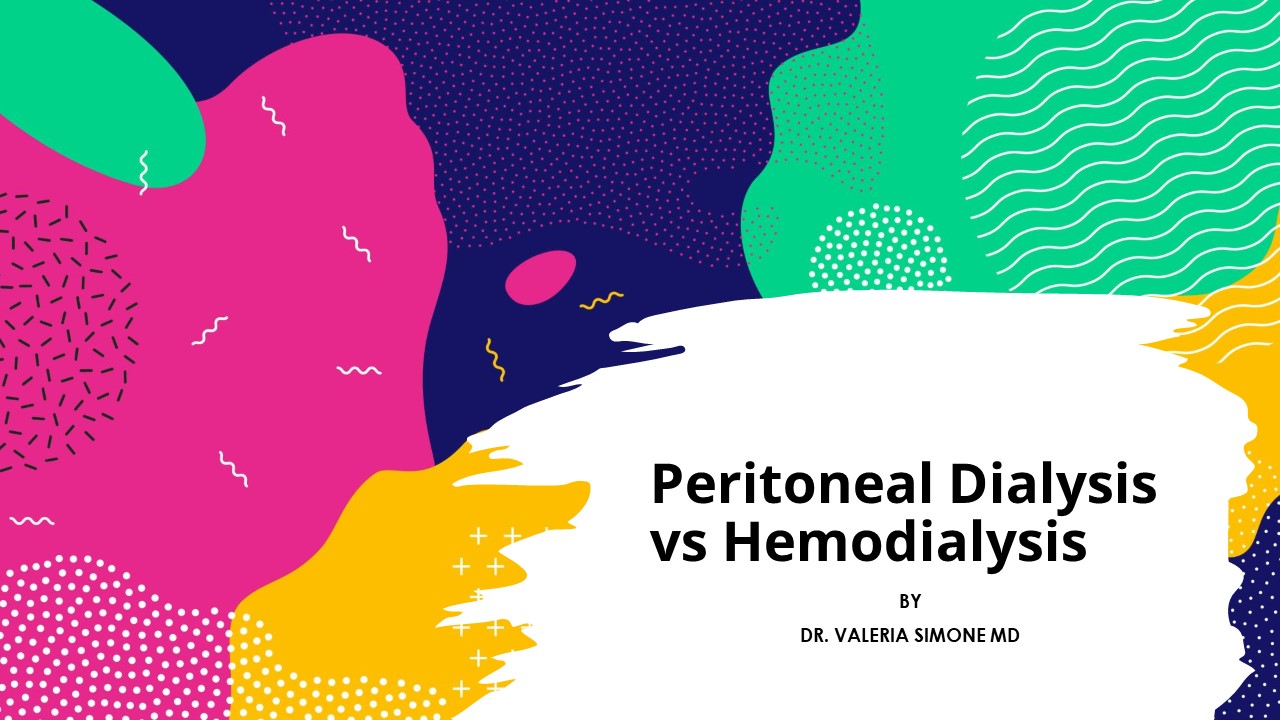Peritoneal Dialysis vs Hemodialysis - PowerPoint PPT Presentation
Title:
Peritoneal Dialysis vs Hemodialysis
Description:
Peritoneal dialysis and hemodialysis are the two primary methods to consider when selecting whether dialysis treatment is best for a certain patient. Hemodialysis is a method of eliminating waste and toxins from the body by using a dialyzer and artificial blood vessels. Let's explore more: – PowerPoint PPT presentation
Number of Views:3
Title: Peritoneal Dialysis vs Hemodialysis
1
Peritoneal Dialysis vs Hemodialysis
- By
- Dr. Valeria Simone MD
2
Overview
- Peritoneal dialysis and hemodialysis are the two
primary methods to consider when selecting
whether dialysis treatment is best for a certain
patient. Hemodialysis is a method of eliminating
waste and toxins from the body by using a
dialyzer and artificial blood vessels. - Usually, hemodialysis is performed three times
weekly, for three to four hours each session, at
a specialized clinic called a dialysis facility.
By contrast, vascular access is not required for
peritoneal dialysis because the patients own
peritoneal membrane serves as the filter. - The Kidneys remove and filter body waste and
other excess fluids in the blood. All this waste
is further sent to the bladder to be wiped out
from the body when you urinate. Dialysis is a
procedure that filters and sanitizes blood with
the help of a machine. - If Kidneys are not functioning and they are
failed to eliminate the waste from the body
doctors prescribe performing Dialysis. In
reference to the National Kidney Foundation, when
kidneys are functioning at only 10-15 percent of
their normal capacity its considered the last
stage of kidney failure. During this treatment
body fluids and electrolytes are balanced and
maintained when the kidneys arent functioning.
3
(No Transcript)
4
What is the objective to use dialysis?
- Kidneys functioning to their full capacity
extract extra water, impurities, and other waste
from pulling up in the body. Kidneys also help to
control blood pressure and maintain the balance
of various other chemical elements such as sodium
and potassium in the body. In fact, kidneys
release a form of Vitamin D that improves calcium
retention. - Due to any injury or disease, when kidneys cant
filter the impurities of the body, dialysis is
best prescribed as an alternative to avoid any
damage to other organs. In the absence of
dialysis, salt and other waste accumulates in the
blood and poison the body, and may even lead to
death.
5
How many types of Dialysis are available?
- There are three distinct sorts of dialysis to
prescribe. - Hemodialysis treatment
- Hemodialysis is the most recommended type of
dialysis. An artificial kidney (hemodialyzer) is
used in this procedure to filter the impurities
and extra fluid from the blood. - Blood is passed through the artificial kidney for
purification and then filtered blood is again
entered into the body with the help dialysis
machine. - To get adequate blood flow to the artificial
kidney, your doctor creates an entrance point
(vascular access) into your veins through
surgery. There are three types of entrance
points - Vascular access catheter. This is injected into
the large vein in your neck. - Arteriovenous (AV) fistula In this procedure, an
artery and a vein are connected, and it is the
most suitable option to perform. - AV graft It is a looped tube.
- AV fistula and AV graft, both are intended for
long-term dialysis treatments. The individual who
has gone under AV fistula procedure gets healed
quickly and can start hemodialysis in 2 to 3
months after their surgery. Catheters are
designed to use for temporary or short-term
procedures.
6
Peritoneal dialysis treatment
- In Peritoneal dialysis, a peritoneal dialysis
(PD) catheter is implanted through surgery into
your abdomen. This catheter allows the filtering
of blood through the peritoneum, a membrane in
the stomach. - Under this treatment, a special fluid known as
dialysate circulates into the peritoneum, and
dialysate absorbs the impurities or waste of the
body. Once dialysate collects impurities out of
the circulatory system, its released from the
abdomen. - This entire process takes about a couple of hours
and requires replicating 5-6 times daily.
Although, this process can be performed while
youre sleeping or awake.
7
What are other options or alternatives to
dialysis?
- Dialysis is an expensive and time-consuming
process, and not every individual wants to choose
it, mainly if there is severe or acute kidney
failure. - If you dont wish to choose dialysis, there are
other alternative treatment options are available
to help and improve your condition. Anemia
management is one of the available options you
can choose to pursue. - When Kidneys function properly, the body
naturally produces the hormone erythropoietin
(EPO) and when kidneys are not functioning to
their capacity you can choose to get injected
with EPO every week. - Another alternative for individuals is a kidney
transplant, however, it has long-term commitment.
Consult your doctor to check if a transplant is
feasible for you. You might not be able to go for
a kidney transplant if you - smoke
- overweight
- intensely consume alcohol
- Have untreated health ailments
8
When dialysis should be stopped?
- Dialysis saves the lives of those who have
reached end-stage renal disease (ESRD). This
procedure involves removing contaminants and
waste products from the blood and urine that the
kidneys are unable to handle. - Lets explore more Peritoneal Dialysis vs
Hemodialysis - Southlake General Surgery
9
Appointment
- For more information on Peritoneal Dialysis vs
Hemodialysis, you can contact our healthcare
expert today at 1 (817) 748-0200. You can also
make an online appointment with us. - Follow us on Facebook and YouTube.
- Source Peritoneal Dialysis vs Hemodialysis -
Southlake General Surgery
10
THANK YOU!
SOUTHLAKE GENERAL SURGERY
1545 E. Southlake Blvd, Suite 270 Southlake, TX
76092
EMAIL info_at_southlakegeneralsurgery.com
VISIT US AT www.southlakegeneralsurgery.com































